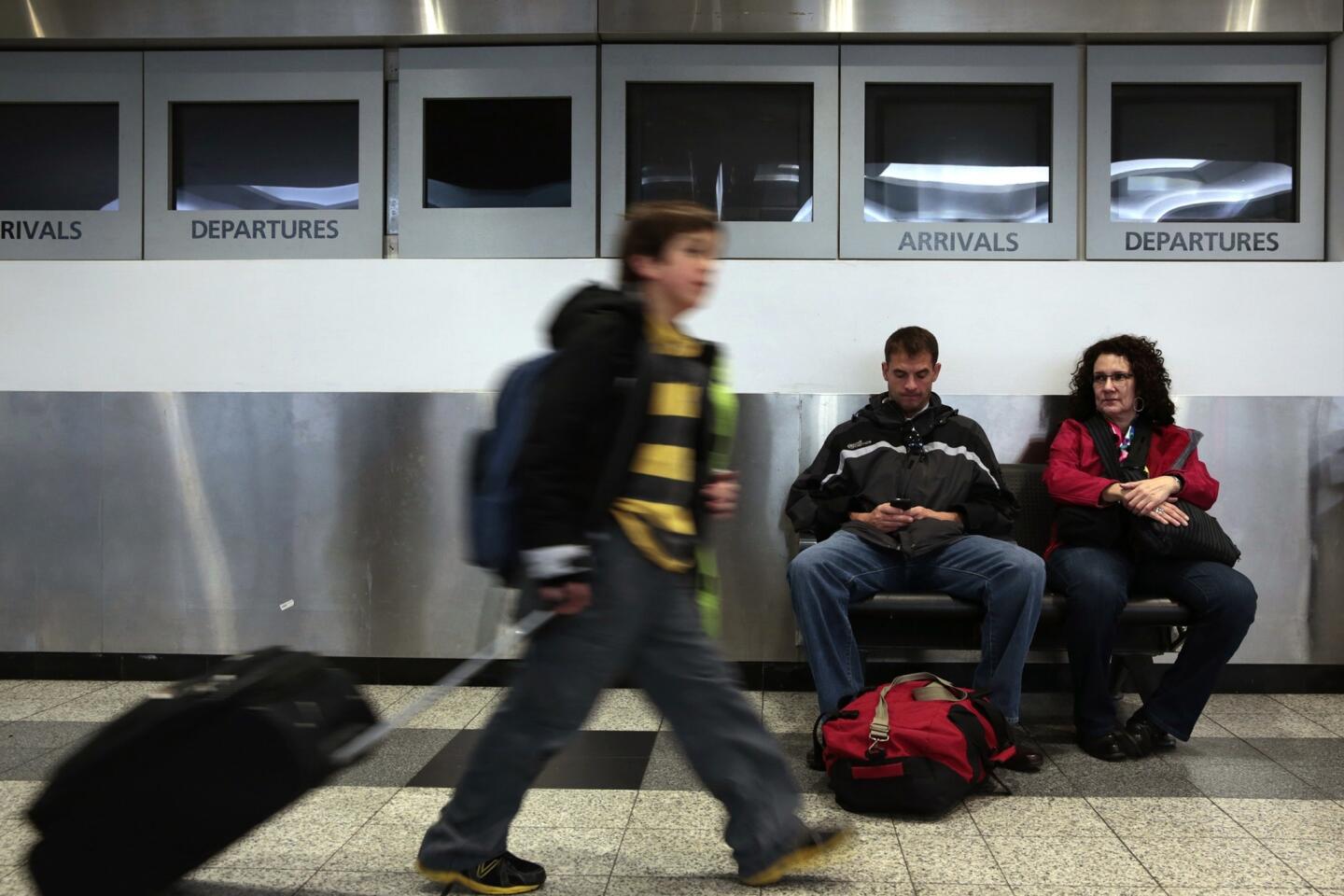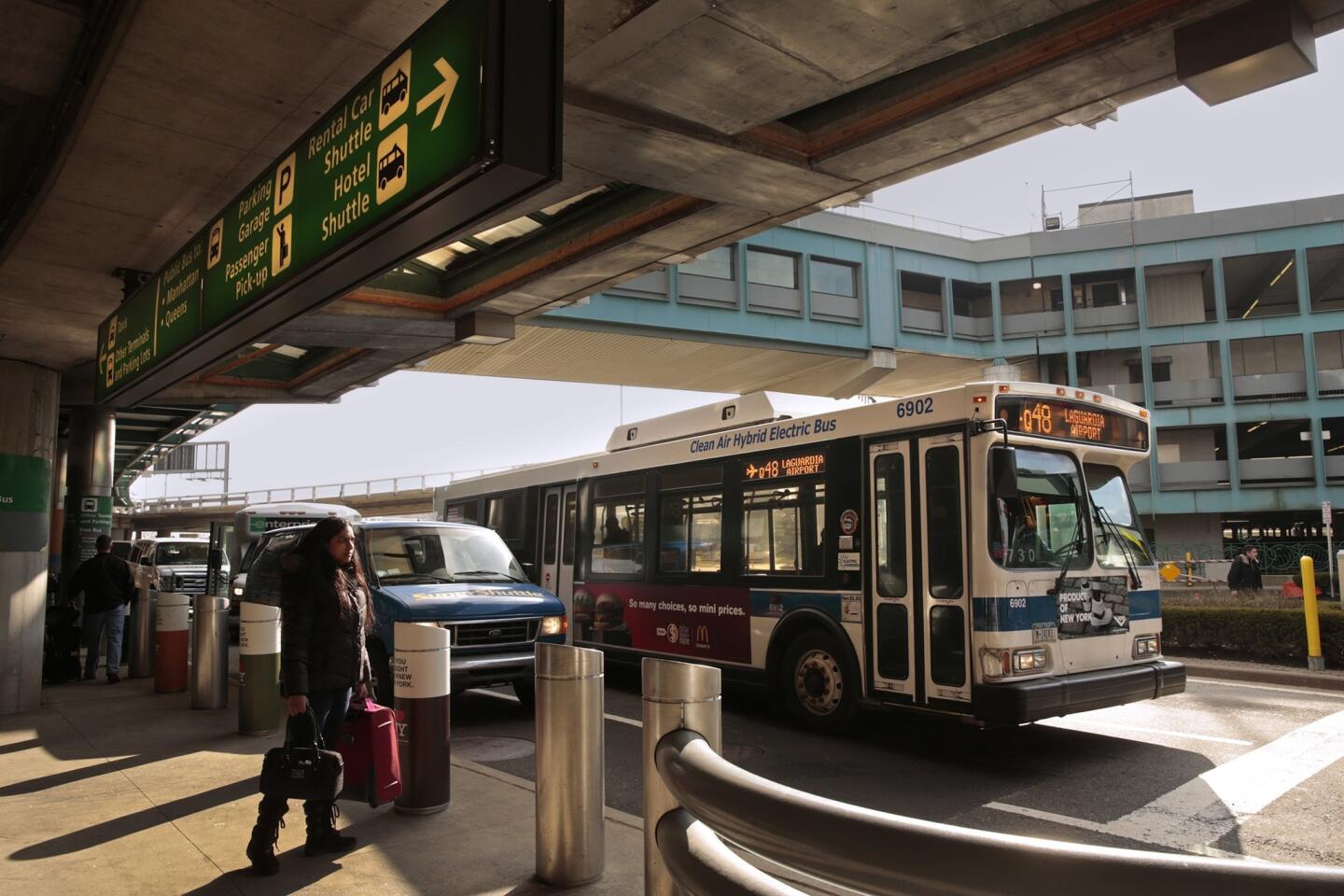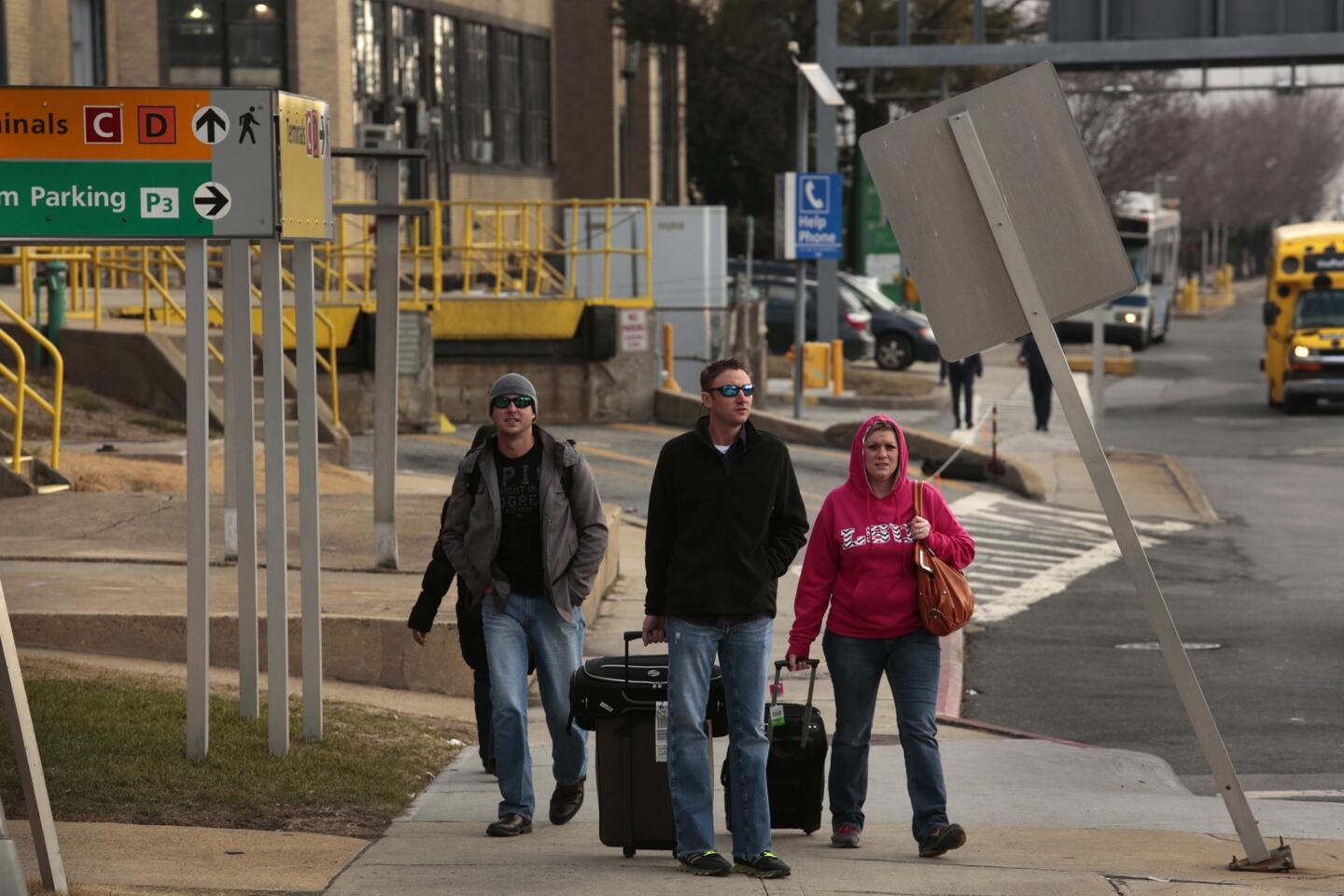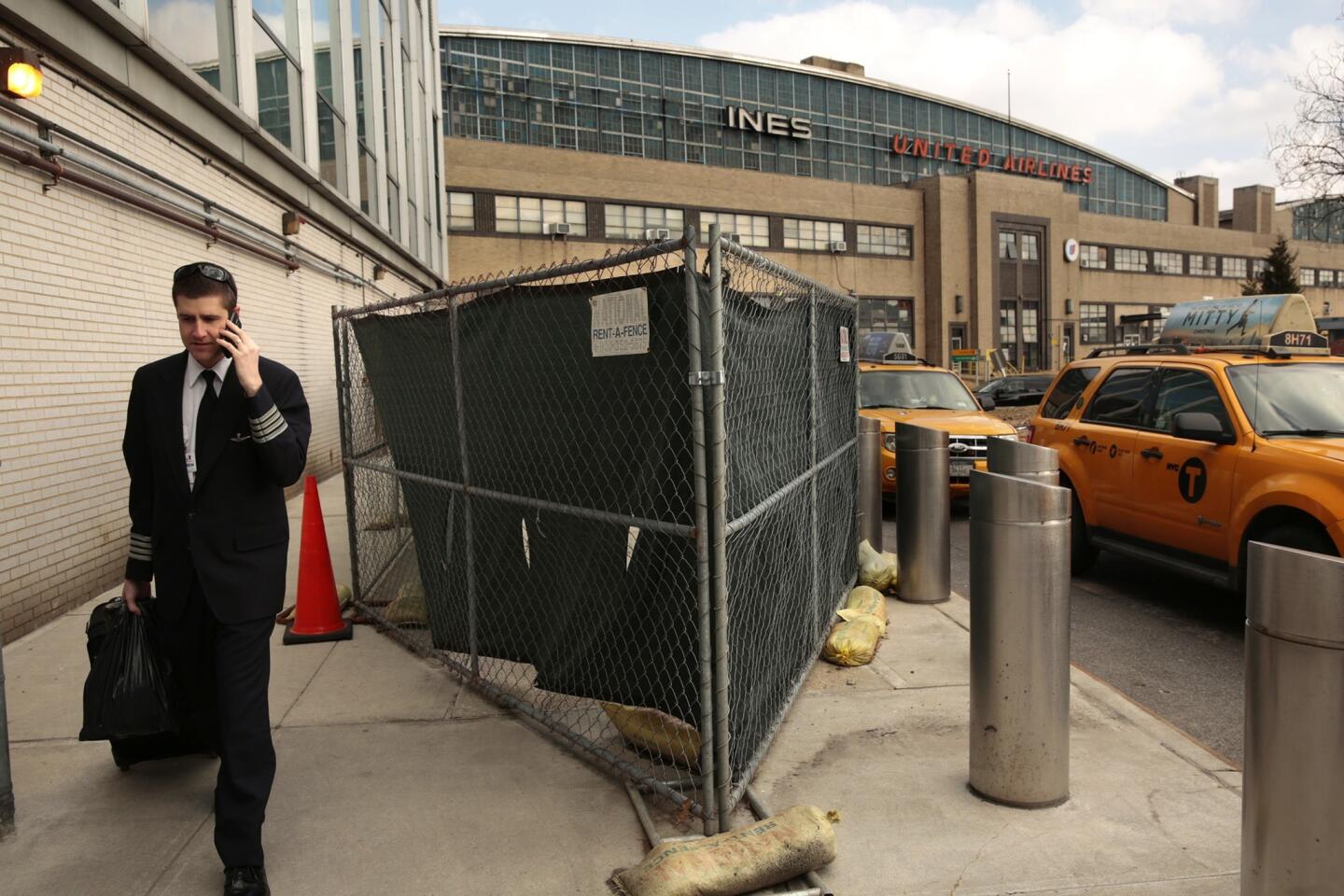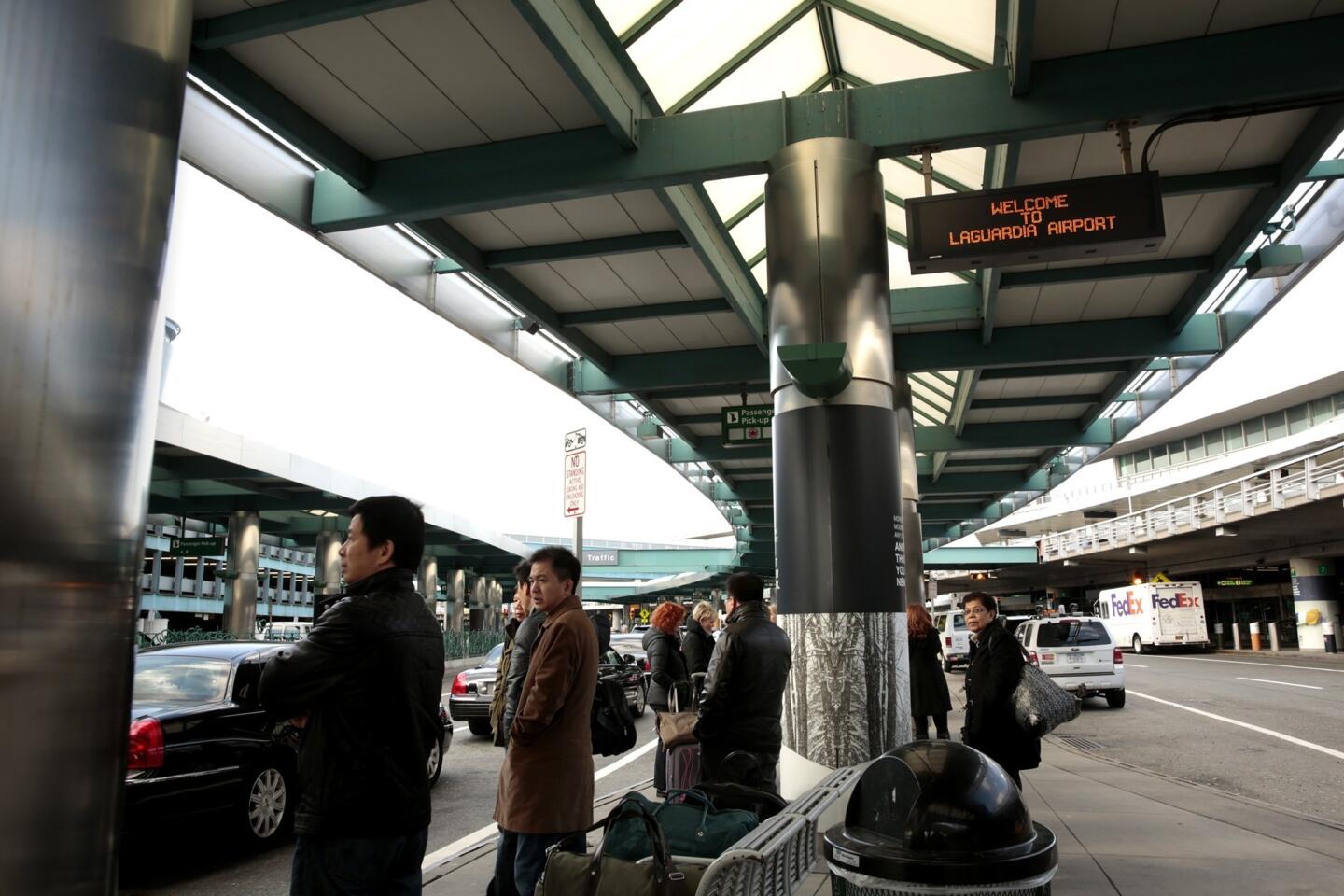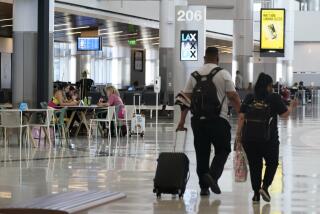New York’s LaGuardia Airport is almost a terminal case
- Share via
NEW YORK — The bus was standing room only as travelers hauling luggage jostled for space amid the commuters and other local riders. Two men with skis, ski boots and backpacks squeezed into the nook beside the rear exit, blocking the door. A woman with two children and three suitcases struggled to drag the bags up the narrow aisle as the bus bounced through Manhattan and Queens to its destination: LaGuardia Airport, otherwise known as “America’s worst airport.”
How bad is LaGuardia?
It’s so bad that New York Gov. Andrew Cuomo denounced it during his State of the State address this month. “LaGuardia Airport is ranked the worst airport in America,” Cuomo bellowed. “That is a disgrace, my friends. And it is unacceptable.” He vowed to take over a planned $3.6-billion modernization project from the airport’s manager, the Port Authority of New York and New Jersey, to move it along.
It’s so bad that airport design expert John D. Kasarda offered condolences, not entirely in jest, upon learning that a caller was phoning from LaGuardia.
It’s so bad that in 2010, when he headed the Port Authority, Christopher Ward suggested LaGuardia be torn down.
“The airport, quite frankly, is dingy,” said Kasarda, director of the Center for Air Commerce at the University of North Carolina’s Kenan-Flagler Business School.
Dingy it is, from the grimy windows of Terminal A, whose old Delta Air Lines sign reads just “ines,” to the water-stained ceilings, grim lighting and lack of seating. Its concourses are too small to accommodate the passenger load and post-2001 security, leaving people squeezed like cattle into lines that back up at the checkpoints. On the Monday before Christmas, plastic buckets sat on the floor of the main terminal, catching rain as it dripped through the low-slung ceiling.
LaGuardia has had plenty of competition in the dismal airport sweepstakes, including from Los Angeles International. In 2012, Travel + Leisure magazine ranked LAX the nation’s second-worst airport, behind LaGuardia, with readers complaining about dirty terminals and balky check-in and security systems. But LAX is undergoing a $4-billion face-lift, and last year its newly remodeled Tom Bradley International Terminal was opened to reveal additional gates, expanded immigration facilities and a gleaming, grand atrium packed with upscale shops. More improvements are in the works.
San Francisco International unveiled a flashy new Terminal 2 in 2011, which includes nearly 350 outlets for laptops and chargers and a “recompose” area for passengers to pull themselves together after going through security. In 2000, it opened a new international terminal featuring marble hallways, a full medical clinic and the country’s first airport-based Gucci store.
To be fair, LaGuardia moved up a spot, to second-worst U.S. airport, in Travel + Leisure’s latest survey (the airport in Little Rock, Ark., was deemed the worst), and many constraints are out of its control.
Its passenger load is soaring — 25.7 million in 2012, making it the nation’s 21st busiest airport — but it has just two runways and space for 76 gates. By comparison, Boston’s Logan Airport, with 29 million passengers the same year, has six runways and more than 100 gates. LaGuardia’s flights are increasing, but there is no space for expansion. Its legendary delays often are exacerbated by tie-ups at John F. Kennedy and Newark Liberty international airports, which share its jammed airspace.
And LaGuardia is run by the Port Authority, a bureaucratic behemoth whose political appointees from neighboring states have competing interests. Lately, the agency has been embroiled in “Bridgegate,” the scandal surrounding the politically motivated closure of the George Washington Bridge allegedly orchestrated by a top aide to New Jersey Gov. Chris Christie.
“The city deserves better,” Kasarda said. “It’s run on political grounds rather than business grounds, and the outcome is apparent.”
In various surveys since 2006, LaGuardia has usually ranked as the worst U.S. airport based on delays, cleanliness and amenities such as free Internet and subway access. (Note to travelers about subway access: There isn’t any.)
“What is there to like about LGA?” Travel + Leisure said last year. “Not much.”
“There’s so much said about the nightmare of travel now, and if the gateway is a really unpleasant one, it does make the whole idea of travel less enticing,” said Nancy Novogrod, the magazine’s editor in chief. Novogrod takes particular exception to the airport’s bathrooms, with their spotty maintenance and limited hand dryers and towel dispensers, which practically guarantee wet floors and countertops. On a recent day, the distinct odor of dirty diapers wafted into Terminal D from one bathroom.
“People have seen mice. It’s dirty. It’s gross,” said Sarah Sanders, who travels regularly between New York and Milwaukee. Sanders was rushing in her business suit and heels from Terminal D to Terminal C, dragging a rolling suitcase and carry-on bag. This involved going outside and crossing two access routes used by taxis lining up for fares. She passed the unfenced and well-used pet relief area, a dirt patch beneath an overpass to the left of the walkway.
Inside Terminal C, where seats are few, a man had crawled onto a narrow ledge between a window and an escalator to sleep on the heating vent. Another lay on the floor next to a wall.
The machine to pay for parking was broken. Arriving passengers had to pay $5 if they wanted a luggage cart. Those who did not want to spring for a cab or shuttle crowded bus stops outside. The public buses have no undercarriages for luggage, leaving passengers to haul their bags up the steep steps.
“It was a jewel when it was built,” said Stephen Sigmund, the executive director of New York’s Global Gateway Alliance. That was 1939. The advocacy group has long pushed for improvements to the city’s airports, especially LaGuardia, but modernization efforts stalled.
“The subways, roads, big major buildings — there’s a million infrastructure projects that jump to the front of the line,” Sigmund said.
Despite New York’s celebrated status as one of the world’s top tourist and business destinations, all its major airports lag behind those in Asia, the Middle East and Europe, where passengers can work, relax on comfortable seats and, perhaps most important, pump billions of dollars into local economies by dining and shopping.
Sigmund said New York airports had also fallen decades behind other U.S. airports, where major renovations or piecemeal improvements have lifted conditions from the wretchedness seen in New York.
Nowhere is the wretchedness felt as starkly as at LaGuardia, which was named for one of the city’s most beloved mayors, Fiorello LaGuardia. Its main selling point — it is less than 10 miles from midtown Manhattan — is undercut by the fact that, unlike JFK and Newark, it has no subway or train for travelers to get there.
Amid the gloom, there are signs of hope.
Delta Air Lines, which uses LaGuardia as a hub, last year began a $160-million upgrade of terminals C and D. The improvements, which aren’t visible until you go through security, get high marks for food options and for the iPads attached to desks, which offer free Internet access. There’s even a beer garden featuring craft beers, which opened recently in Terminal C.
“So little things are being done,” Novogrod said.
The Port Authority has chosen four finalists from bidders vying to build a new main terminal at LaGuardia. The agency’s plan would replace the 835,000-square-foot terminal with a 1.3-million-square-foot structure and bring other infrastructure upgrades, from garages to aircraft hangars. But no contractor has been named, and the predicted completion year?
2021.
“We think it’s the right thing to do,” Sigmund said. “We’d just like them to speed it up.”
More to Read
Sign up for Essential California
The most important California stories and recommendations in your inbox every morning.
You may occasionally receive promotional content from the Los Angeles Times.
